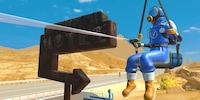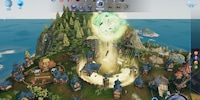
Background information
Powerwash Simulator and many more: why we like boring busywork in our games
by Rainer Etzweiler

From 100-second news to 30-second TikToks, 250-character tweets and articles with displayed reading times – the world is vying for our rather limited attention. Are we even capable of concentrating on one thing for longer anymore?
Can’t remember the last time you read a book, fully focused, within just a few days? Do you only skim online articles based on the subheadings? And where do you keep your smartphone when watching a movie? Do you only watch the movie – or do you also text on the side?
Guilty? No shame, I’ve been there. It may be reassuring to know that we all struggle with our attention spans, and not just since the age of the smartphone. Recent studies show the human brain is simply not made to devote itself to one and the same task for a long time. It constantly needs new stimuli.
Social networks such as Instagram, TikTok and the like take advantage of precisely this. It’s no coincidence that doomscrolling has become a widespread phenomenon and an established term, manifesting in hours of swiping and scrolling through various apps – and being no better off for it.
In his book Stolen Focus: Why You Can't Pay Attention, published in 2022, British journalist and author Johann Hari describes the spotlight of our attention in an even more nuanced way. He differentiates between four types of attention: spotlight, starlight, daylight and stadium lights. But what does each of them mean?
Attention is always accompanied by distraction – just as light is accompanied by shadow. This is where the concept of interference comes into play. Interference describes distraction from or interruption of an action due to irrelevant information, background noise, other people, devices, thoughts and so on.
According to two experts – Adam Gazzaley (MD, PhD), a neuroscientist and one of the pioneers of brain distractions and interruptions, as well as Larry Rosen (PhD), a psychologist specialising in the «Psychology of Technology» – interference falls into two categories: internal and external.
According to the scientists, internal and external interference has always existed. It’s not a phenomenon of the modern age, caused by smartphones, computers and other kinds of media. Distractions can always arise, be it a glass from the neighbouring table shattering or a conversation you had with your boss preoccupying you at after-work drinks with a friend. The positive view of this may be that it’s multitasking; the negative that it’s more of a distraction.
The trick is to regain your attention and concentrate fully on the here and now. But how, given people have long been inclined to spend an average of just three minutes on a task?
Fortunately, these three minutes don’t apply to the working world. Here, the same study showed a concentration time of eleven and a half minutes before the person moved on to another task. That’s not much either. But there are tools and techniques that can be used to increase this time. Here are some tips for success:
Speaking of timers: «Stolen Focus» author Johann Hari also often gets distracted. To use his time more productively and stop himself from constantly reaching for his smartphone (we do so around 1,600 times in 24 hours!), he literally locks it up. He uses the KSafe, which at first glance looks like your bog-standard plastic container. The clou is in the lid, which houses a digital timer that allows you to set lock times from 15 minutes to two weeks.
Alternatively, you can set your phone’s interface to appear in grayscale to make it less attractive. Perhaps this will help you to reduce the time spent on your phone, which is reportedly just over three hours a day on average.
Another aspect that hinders concentration is noise. One possible tool to combat it are the brown noise and white noise trends.
However, people who suffer from breathing disorders during sleep (such as obstructive sleep apnoea) also often have problems concentrating the next day and suffer from fatigue. One possible way to increase concentration and boost productivity is power napping. According to new research, 30 to 60 minutes is already enough to regenerate energy.
This has led companies like Google, NASA, Samsung and HuffPost to create relaxation spaces where employees can recharge their batteries. And in Vienna, Siesta Consulting advises people and companies of the benefits of resting at lunchtime and how it can contribute to an organisation’s success.
Notebook, camera, laptop or smartphone. For me, life's about taking notes – both analogue and digital. What's always on me? My iPod Shuffle. It's all in the mix, after all. This is also reflected in the topics I write about.
Interesting facts about products, behind-the-scenes looks at manufacturers and deep-dives on interesting people.
Show all
Background information
by Rainer Etzweiler

Background information
by Katherine Martin

Background information
by Kim Muntinga
The good news is you can do something about this – if you know your own attention span and ability to concentrate. Although there’s no consensus in psychology on attention models (there are various theories that describe the functions of attention), attention has been described as a kind of «spotlight» (linked dissertation in German) that enables us to focus on current or generally important issues. This can be a conscious or subconscious process – you may be trying to recall a name or a scene from your memory, or your thoughts may wander as something else comes to mind.
Why exactly something grabs your attention or distracts you from something else isn’t yet clear. Introductory books on psychology (linked book in German) are full of different approaches, ranging from selective to dimension-based attention. Much of this therefore depends on individual preferences. What exactly gets your attention is up to you. So let’s ask the other way around: what distracts you?
Internal interference refers to distractions we ourselves cause, such as wandering thoughts. External interference refers to external distractions – take sensory stimuli, such as the background noise in a restaurant, or acoustic, vibrating or flashing visual signals, as the two authors describe in their book The Distracted Mind: Ancient Brains in a High-Tech World (link to English version in Google Books).
Jumping back and forth between many projects, applications and things isn’t conducive to your attention. While the constant flow of new stimuli keeps your reward centre happy, it’s detrimental to the actual task at hand. This behaviour becomes particularly problematic if you regularly multitask. Studies have shown that this can establish habits that cannot be easily reversed.
A good plan is half the battle won, as the saying goes – and there’s a lot of truth in that. You’ll gain a lot by creating a good, realistic schedule for completing specific tasks. The only important thing is to not set too ambitious goals that are nigh unachievable. That’s why it’s the honest and right thing to do to critically question deadlines and schedules that seem too tight in your professional life, too. Nothing’s as disruptive to your concentration as the knowledge of certain failure.
A distraction-free environment is incredibly important for your ability to concentrate – sounds almost too simple, yet it’s true. Recent studies confirm what you’re likely already aware of. Namely that our smartphones are the number one distraction. Mind you, it’s not the device itself, but rather social media that consumes most of our attention. In other words, if you want to concentrate on your work, make sure that your smartphone is at least switched to silent or in flight mode – or put it away entirely. Most devices also allow you to set timers for specific apps, making the app available during a set part of the day only.
If you monitor your sleep with a smartwatch, you’ve certainly experienced being warned by your watch that you may experience difficulty concentrating after a poor night’s sleep. But even without a watch, you can feel the effects of a restless night. There are, of course, also studies showing the importance of good sleep for your health. Accordingly, stress is a major factor when it comes to sleep quality, as is alcohol.
Taking author and journalist Hari’s words to heart, we shouldn’t punish ourselves for finding it difficult to stay focused. Distractions happen, but hating and reprimanding ourselves for it isn’t the way to go. You’re better off following Hari’s lead – think about what you can do to get into a state of flow instead. Perhaps change the environment, switch off your devices, or take a short break? To quote the «Stolen Focus» author: «Seeking out flow, I learned, is far more effective than self-punishing shame.»

Siemens EQ700 integral TQ717D03